Preparation Scheme Optimization of Thermosetting Polyurethane Modified Asphalt
Abstract
:1. Introduction
2. Materials and Methods
2.1. Materials
2.2. Test Method
2.2.1. Splitting Strength and Height Test of PU Specimens
2.2.2. Optimization of PU
2.2.3. Orthogonal Experiment of PU-Modified Asphalt
2.2.4. Tensile Test
3. Results and Discussion
3.1. PU-Modified Asphalt Optimization
3.2. Range Analysis of the Orthogonal Test
3.3. Orthogonal Experimental Difference Analysis
3.4. Response Surface Model
3.5. Tensile Properties
3.6. Failure Surface Analysis
4. Conclusions
- (1)
- Under the same preparation conditions and 10% PU content, the selected PU-1, PU-2, PU-3, and PU-4 materials can improve the mechanical properties of asphalt to varying degrees. Among them, PU-1 has the most significant improvement, at 95% higher than that of base asphalt.
- (2)
- Based on the orthogonal tests and variance analysis, the influence of the related factors on the splitting tensile strength and freeze-thaw splitting strength of PU-modified asphalt at different ages was obtained, and it was found that the PU content was the most significant.
- (3)
- The optimal ratio parameters of PU-modified asphalt are determined as follows: the PU content is 56.64%, the preparation process is the prefabricated method, and the CA content is 3.58%. The establishment of the response surface was found to be highly consistent, which can therefore guide the optimization of the PU-modified asphalt ratio.
- (4)
- Through conducting tensile tests, it was found that the PU asphalt prepared by the best scheme has good tensile properties and flexibility.
- (5)
- Through the analysis of failure surface morphology, it was found that PU-modified asphalt significantly improves the strength of the binder–aggregate interface, and the material performance was found to be excellent. PU-modified asphalt exhibits obvious strengthening and toughening effects on the mixture.
Author Contributions
Funding
Institutional Review Board Statement
Data Availability Statement
Acknowledgments
Conflicts of Interest
References
- Cong, L.; Yang, F.; Guo, G.H.; Ren, M.D.; Shi, J.C.; Tan, L. The use of polyurethane for asphalt pavement engineering applications: A state-of-the-art review. Constr. Build. Mater. 2019, 225, 1012–1025. [Google Scholar] [CrossRef]
- Zhao, Q.M.; Jing, S.; Lu, X.J.; Liu, Y.; Wang, P.; Sun, M.; Wang, L. The Properties of Micro Carbon Fiber Composite Modified High-Viscosity Asphalts and Mixtures. Polymers 2022, 14, 2718. [Google Scholar] [CrossRef] [PubMed]
- Hou, X.D.; Xiao, F.P.; Wang, J.G.; Amirkhanian, S. Identification of asphalt aging characterization by spectrophotometry technique. Fuel 2018, 226, 230–239. [Google Scholar] [CrossRef]
- Ryms, M.; Denda, H.; Jaskula, P. Thermal stabilization and permanent deformation resistance of LWA/PCM-modified asphalt road surfaces. Constr. Build. Mater. 2017, 142, 328–341. [Google Scholar] [CrossRef]
- Chen, J.S.; Wang, T.J.; Lee, C.T. Evaluation of a highly-modified asphalt binder for field performance. Constr. Build. Mater. 2018, 171, 539–545. [Google Scholar] [CrossRef]
- Polaczyk, P.; Weaver, S.C.; Ma, Y.T.; Zhang, M.M.; Jiang, X.; Huang, B.S. Laboratory investigation of graphene modified asphalt efficacy to pavement performance. Road Mater. Pavement Des. 2023, 24, 587–607. [Google Scholar] [CrossRef]
- Xiao, R.; Huang, B.S. Moisture Damage Mechanism and Thermodynamic Properties of Hot-Mix Asphalt under Aging Conditions. ACS Sustain. Chem. Eng. 2022, 10, 14865–14887. [Google Scholar] [CrossRef]
- Wang, Y.H.; Polaczyk, P.; He, J.X.; Lu, H.; Xiao, R.; Huang, B.S. Dispersion, compatibility, and rheological properties of graphene-modified asphalt binders. Constr. Build. Mater. 2022, 350, 128886. [Google Scholar] [CrossRef]
- Chen, B.; Dong, F.; Yu, X.; Zheng, C. Evaluation of Properties and Micro-Characteristics of Waste Polyurethane/Styrene-Butadiene-Styrene Composite Modified Asphalt. Polymers 2021, 13, 2249. [Google Scholar] [CrossRef]
- Li, S.; Xu, W.Y.; Zhang, F.F.; Wu, H.; Ge, Q.X. Effect of Graphene Oxide on Aging Properties of Polyurethane-SBS Modified Asphalt and Asphalt Mixture. Polymers 2022, 14, 3496. [Google Scholar] [CrossRef]
- Wu, J.P.; Herrington, P.R.; Alabaster, D. Long-term durability of epoxy-modified open-graded porous asphalt wearing course. Int. J. Pavement Eng. 2019, 20, 920–927. [Google Scholar] [CrossRef]
- Lu, Q.; Bors, J. Alternate uses of epoxy asphalt on bridge decks and roadways. Constr. Build. Mater. 2015, 78, 18–25. [Google Scholar] [CrossRef]
- Qian, Z.D.; Wang, Y.Q.; Song, X. Mechanical Properties on Thermosetting Epoxy Asphalt Waterproof Bond Material for Cement Concrete Pavement Based on Composite Structures. In Proceedings of the International Conference on Civil Engineering and Transportation (ICCET 2011), Jinan, China, 14–16 October 2011; pp. 948–954. [Google Scholar]
- Akindoyo, J.O.; Beg, M.D.H.; Ghazali, S.; Islam, M.R.; Jeyaratnam, N.; Yuvaraj, A.R. Polyurethane types, synthesis and applications—A review. RSC Adv. 2016, 6, 114453–114482. [Google Scholar] [CrossRef]
- Engels, H.W.; Pirkl, H.G.; Albers, R.; Albach, R.W.; Krause, J.; Hoffmann, A.; Casselmann, H.; Dormish, J. Polyurethanes: Versatile Materials and Sustainable Problem Solvers for Today’s Challenges. Angew. Chem. Int. Ed. 2013, 52, 9422–9441. [Google Scholar] [CrossRef] [PubMed]
- Huang, G.; Yang, T.H.; He, Z.Y.; Yu, L.; Xiao, H.X. Polyurethane as a modifier for road asphalt: A literature review. Constr. Build. Mater. 2022, 356, 129058. [Google Scholar] [CrossRef]
- Xu, Y.; Li, Y.Z.; Duan, M.X.; Ji, J.; Xu, S.F. Compaction Characteristics of Single-Component Polyurethane Mixtures. J. Mater. Civ. Eng. 2021, 33, 04021221. [Google Scholar] [CrossRef]
- Xu, Y.; Wu, L.; Lv, X.P.; Chou, Z.J.; Li, W.J.; Ji, J.; Xu, S.F. Improvement of Water Stability of Macroporous Polyurethane Mixture. J. Mater. Civ. Eng. 2022, 34, 04022285. [Google Scholar] [CrossRef]
- Gao, G.H.; Sun, M.; Xu, C.C.; Qu, G.Z.; Yang, Y.H. Interlaminar Shear Characteristics of Typical Polyurethane Mixture Pavement. Polymers 2022, 14, 3827. [Google Scholar] [CrossRef]
- Sun, M.; Zheng, M.L.; Qu, G.Z.; Yuan, K.; Bi, Y.F.; Wang, J. Performance of polyurethane modified asphalt and its mixtures. Constr. Build. Mater. 2018, 191, 386–397. [Google Scholar] [CrossRef]
- Jin, X.; Guo, N.S.; You, Z.P.; Wang, L.; Wen, Y.K.; Tan, Y.Q. Rheological properties and micro-characteristics of polyurethane composite modified asphalt. Constr. Build. Mater. 2020, 234, 117395. [Google Scholar] [CrossRef]
- Yang, F.; Cong, L.; Li, Z.L.; Yuan, J.J.; Guo, G.H.; Tan, L. Study on preparation and performance of a thermosetting polyurethane modified asphalt binder for bridge deck pavements. Constr. Build. Mater. 2022, 326, 126784. [Google Scholar] [CrossRef]
- Lu, P.Z.; Huang, S.M.; Shen, Y.; Zhou, C.H.; Shao, L.M. Mechanical performance analysis of polyurethane-modified asphalt using molecular dynamics method. Polym. Eng. Sci. 2021, 61, 2323–2338. [Google Scholar] [CrossRef]
- Yu, R.; Zhu, X.; Zhang, M.; Fang, C. Investigation on the Short-Term Aging-Resistance of Thermoplastic Polyurethane-Modified Asphalt Binders. Polymers 2018, 10, 1189. [Google Scholar] [CrossRef]
- Jin, X.; Guo, N.S.; You, Z.P.; Tan, Y.Q. Research and Development Trends of Polyurethane Modified Asphalt. Mater. Rep. 2019, 33, 3686–3694. [Google Scholar]
- Zhang, Z.P.; Sun, J.; Jia, M.; Ban, X.Y.; Wang, L.; Chen, L.Q.; Huang, T.; Liu, H. Effects of Polyurethane Thermoplastic Elastomer on Properties of Asphalt Binder and Asphalt Mixture. J. Mater. Civ. Eng. 2021, 33, 04020477. [Google Scholar] [CrossRef]
- Salas, M.Á.; Pérez-Acebo, H.; Calderón, V.; Gonzalo-Orden, H. Bitumen modified with recycled polyurethane foam for employment in hot mix asphalt. Rev. Ing. E Investig. 2018, 38, 60–66. [Google Scholar] [CrossRef]
- Jin, X.; Sun, S.W.; Guo, N.S.; Huang, S.L.; You, Z.P.; Tan, Y.Q. Influence on Polyurethane Synthesis Parameters Upon the Performance of Base Asphalt. Front. Mater. 2021, 8, 656261. [Google Scholar] [CrossRef]
- Zhang, Z.P.; Sun, J.; Huang, Z.G.; Wang, F.; Jia, M.; Lv, W.J.; Ye, J.J. A laboratory study of epoxy/polyurethane modified asphalt binders and mixtures suitable for flexible bridge deck pavement. Constr. Build. Mater. 2021, 274, 122084. [Google Scholar] [CrossRef]
- Yan, W.; Ou, Y.J.; Xie, J.; Huang, T.; Peng, X.H. Study on Properties of Bone Glue/Polyurethane Composite Modified Asphalt and Its Mixture. Materials 2021, 14, 3769. [Google Scholar] [CrossRef]
- Li, C.X. Preparation of polyurethane modified asphalt and road performance evaluation of mixture. J. Wuhan Univ. Technol. Transp. Sci. Eng. 2017, 41, 958–963. [Google Scholar]
- Zhang, Z.P.; Sun, J.; Jia, M.; Qi, B.; Zhang, H.L.; Lv, W.J.; Mao, Z.Y.; Chang, P.T.; Peng, J.; Liu, Y.C. Study on a thermosetting polyurethane modified asphalt suitable for bridge deck pavements: Formula and properties. Constr. Build. Mater. 2020, 241, 118122. [Google Scholar] [CrossRef]
- Jia, M.; Zhang, Z.P.; Yang, N.; Qi, B.; Wang, W.T.; Huang, Z.G.; Sun, J.; Luo, F.K.; Huang, T. Performance Evaluation of Thermosetting and Thermoplastic Polyurethane Asphalt Mixtures. J. Mater. Civ. Eng. 2022, 34, 04022097. [Google Scholar] [CrossRef]
- JTG E20-2011; Standard Test Methods of Bitumen and Bituminous Mixtures for Highway Engineering. Ministry of Transport of the People’s Republic of China: Beijing, China, 2011.
- ISO 37:2017; Rubber, Vulcanized or Thermoplastic—Determination of Tensile Stress-Strain Properties. International Organization for Standardization: Geneva, Switzerland, 2009.
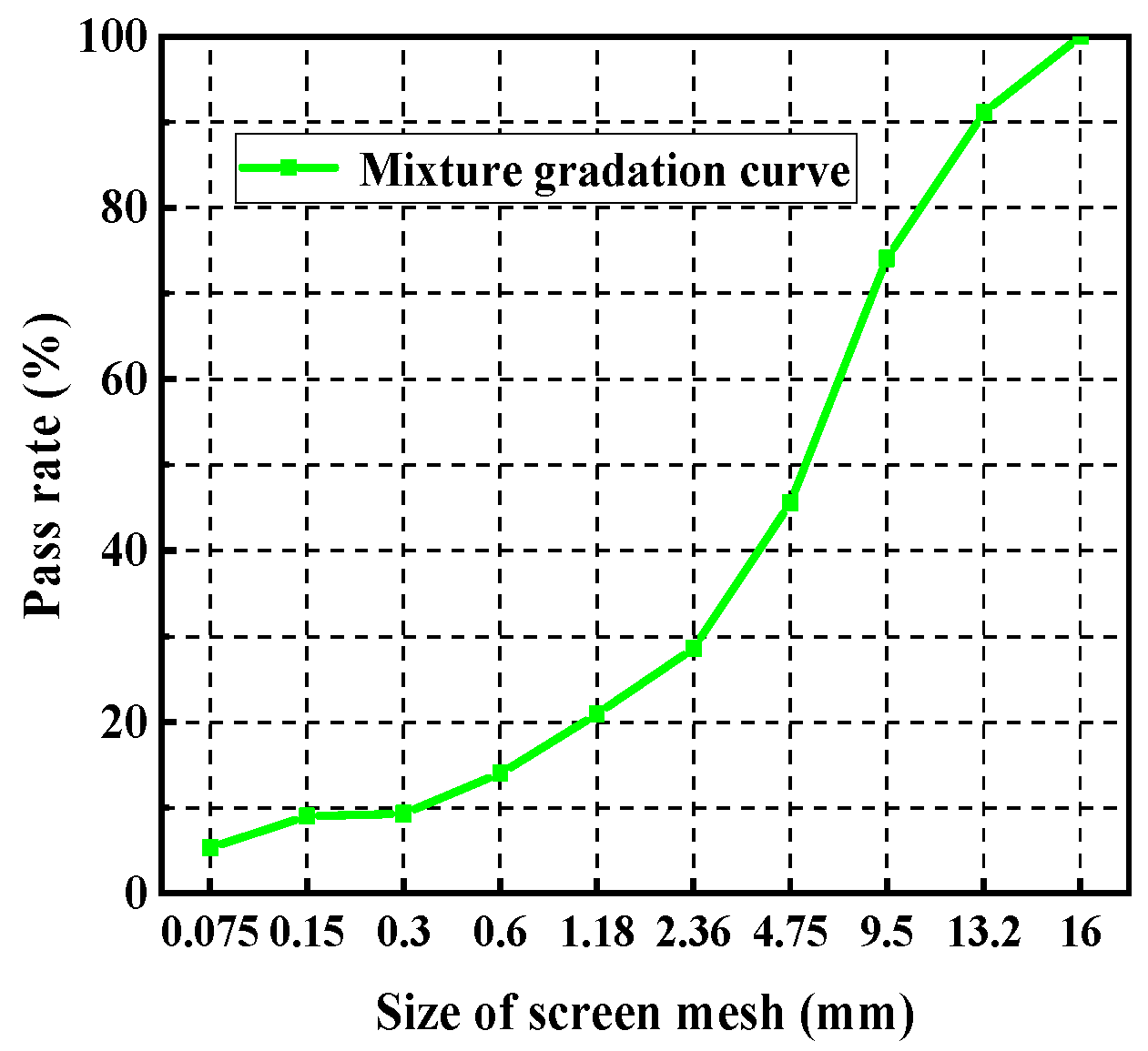


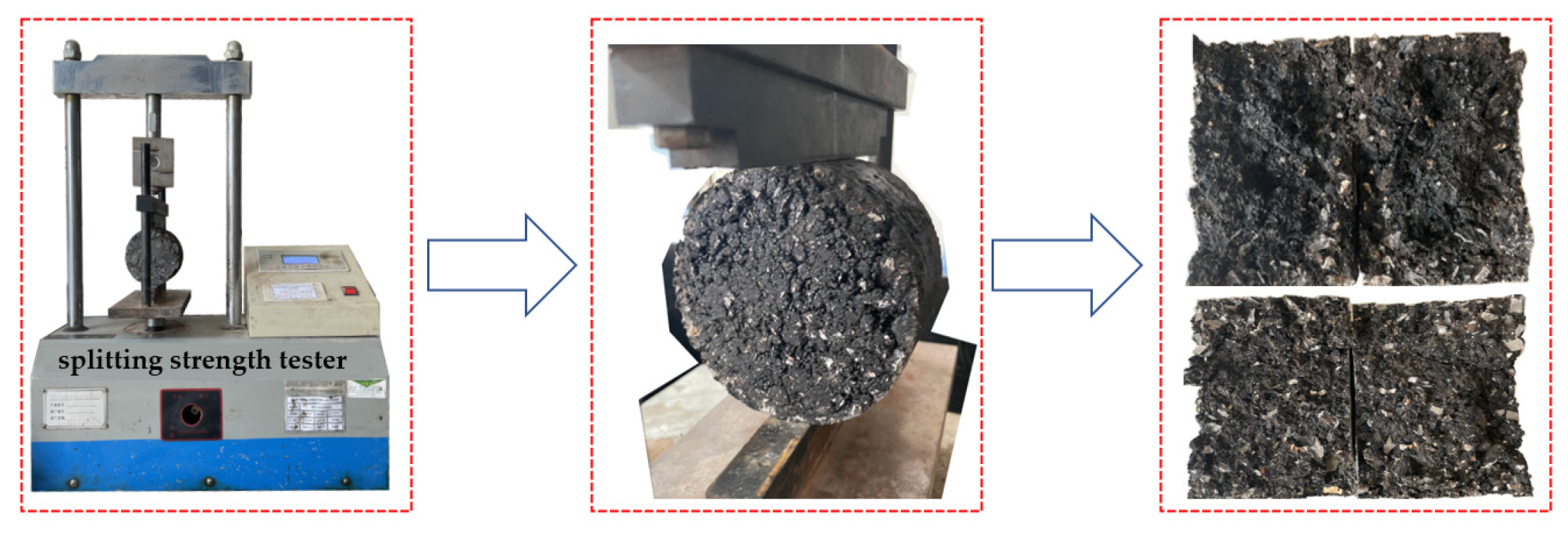



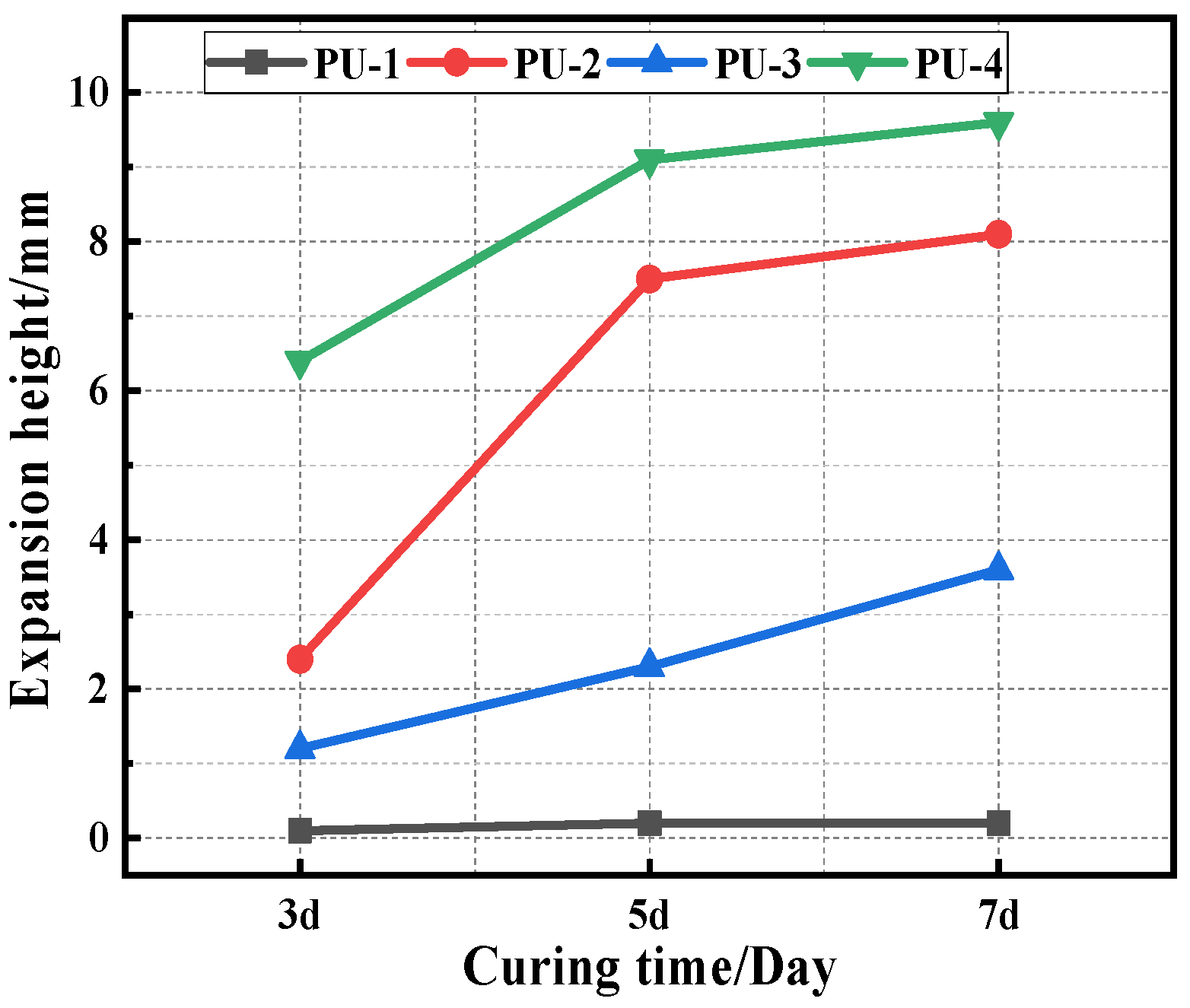

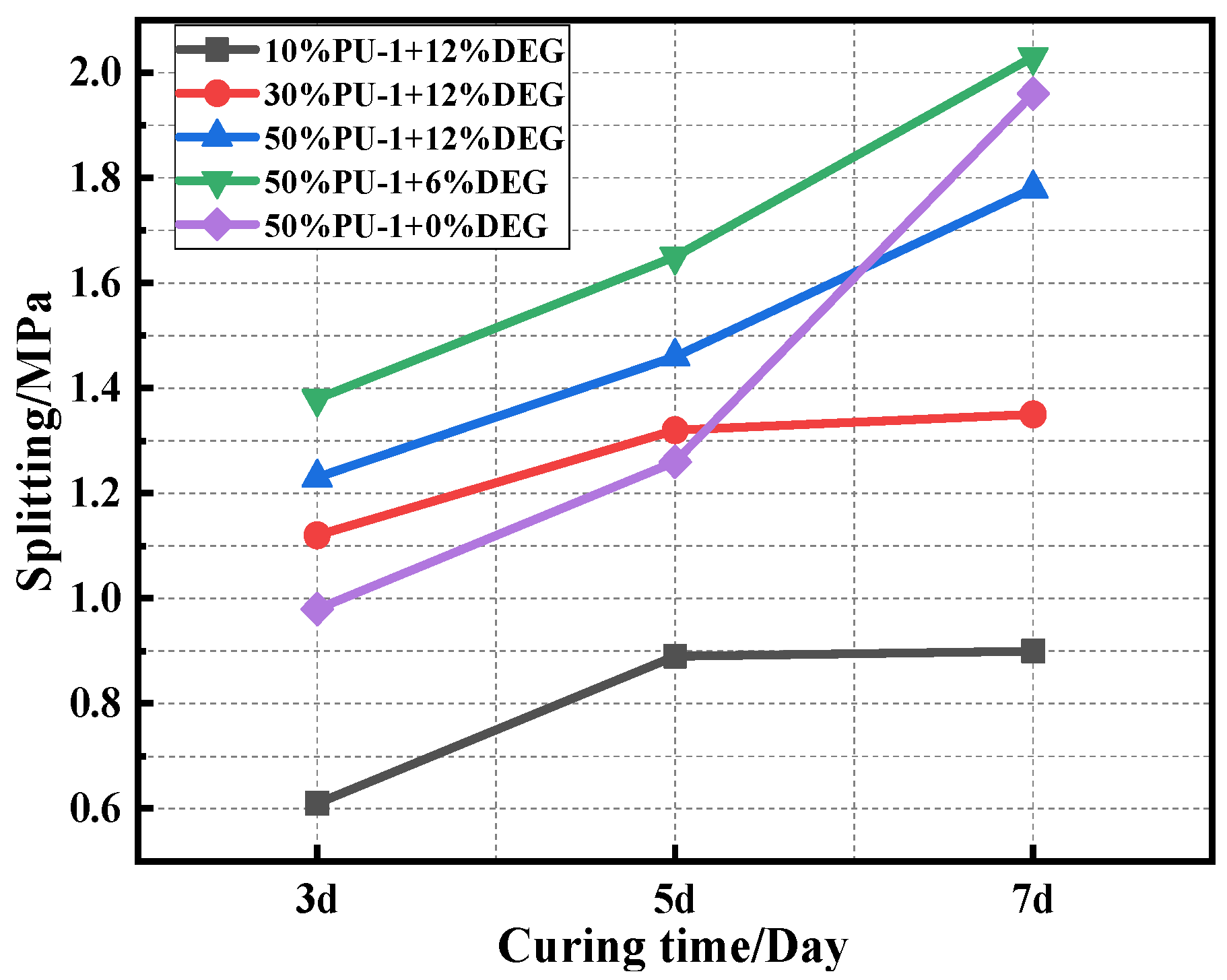




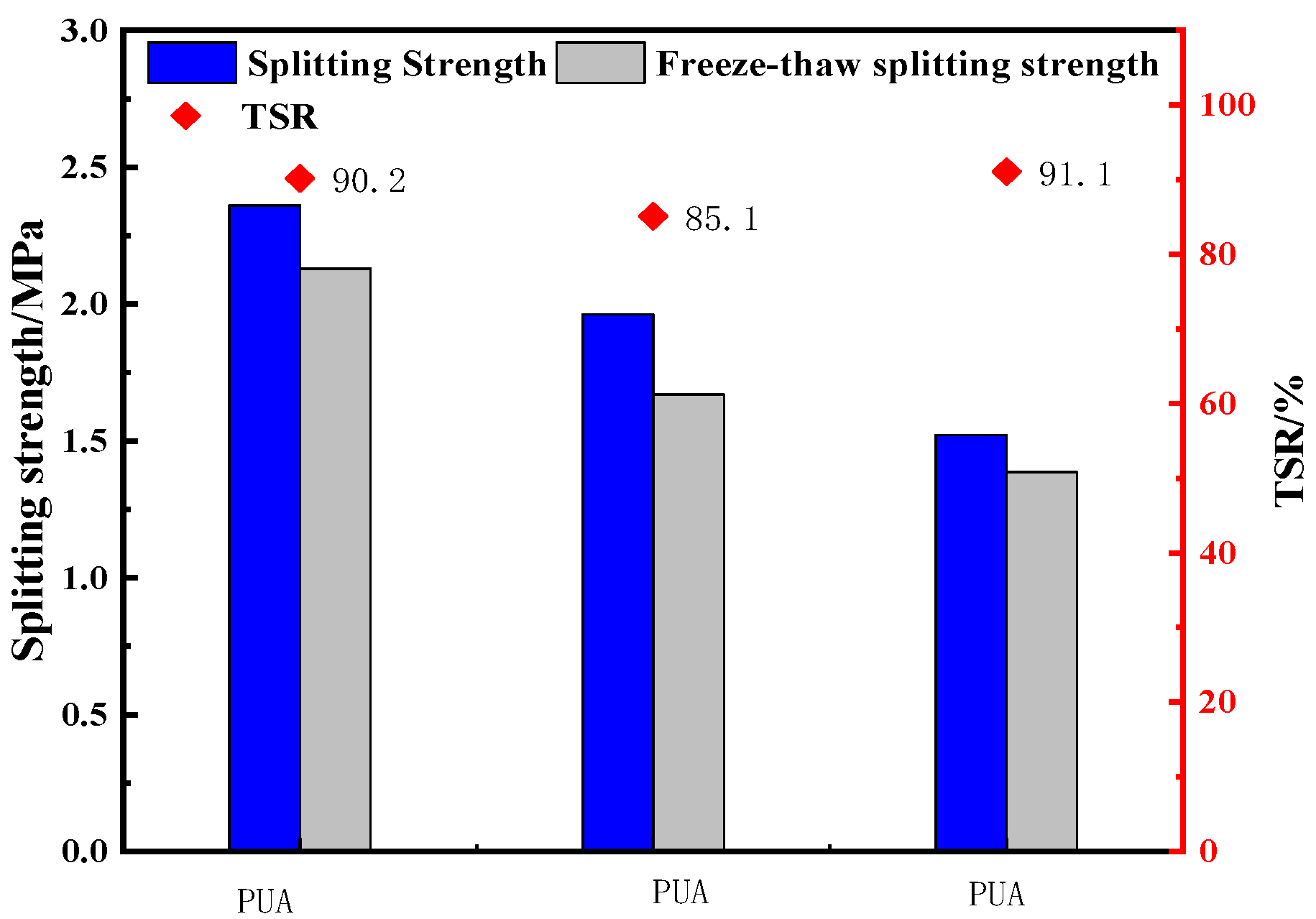
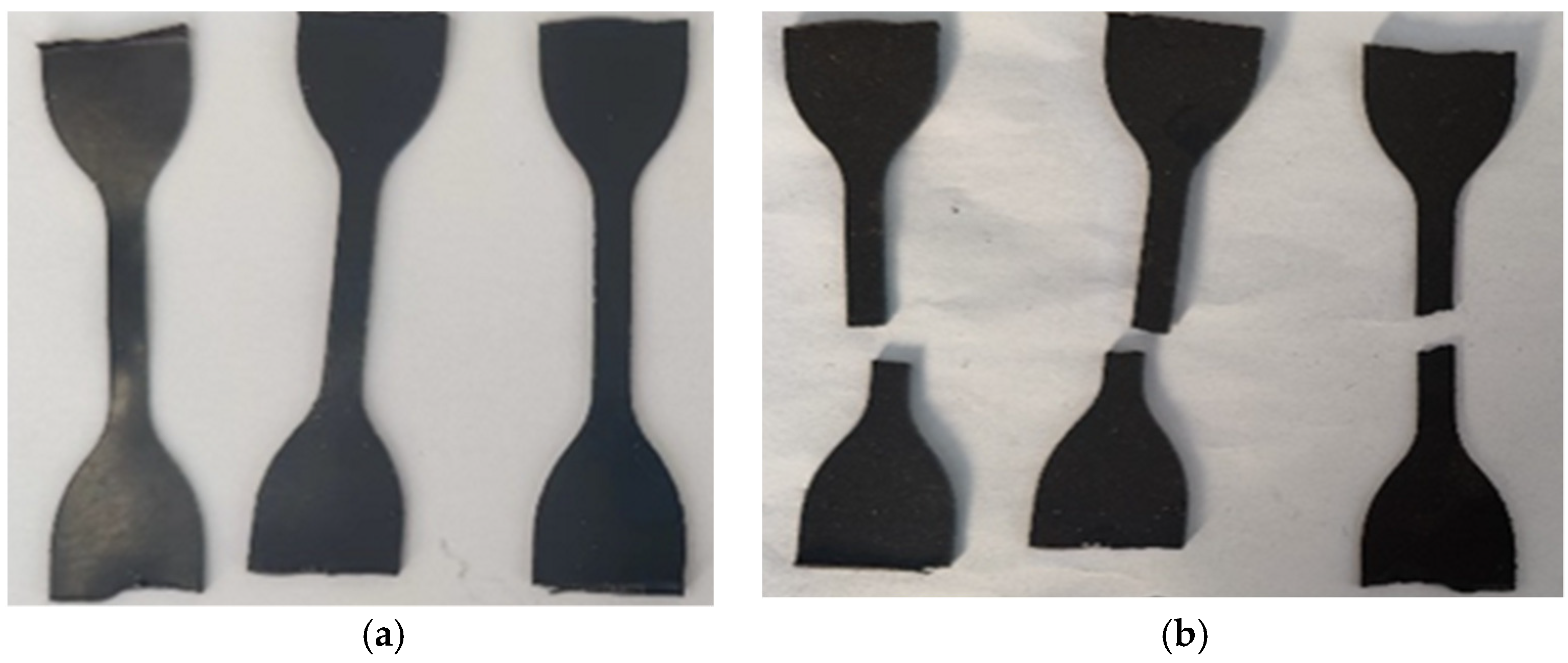
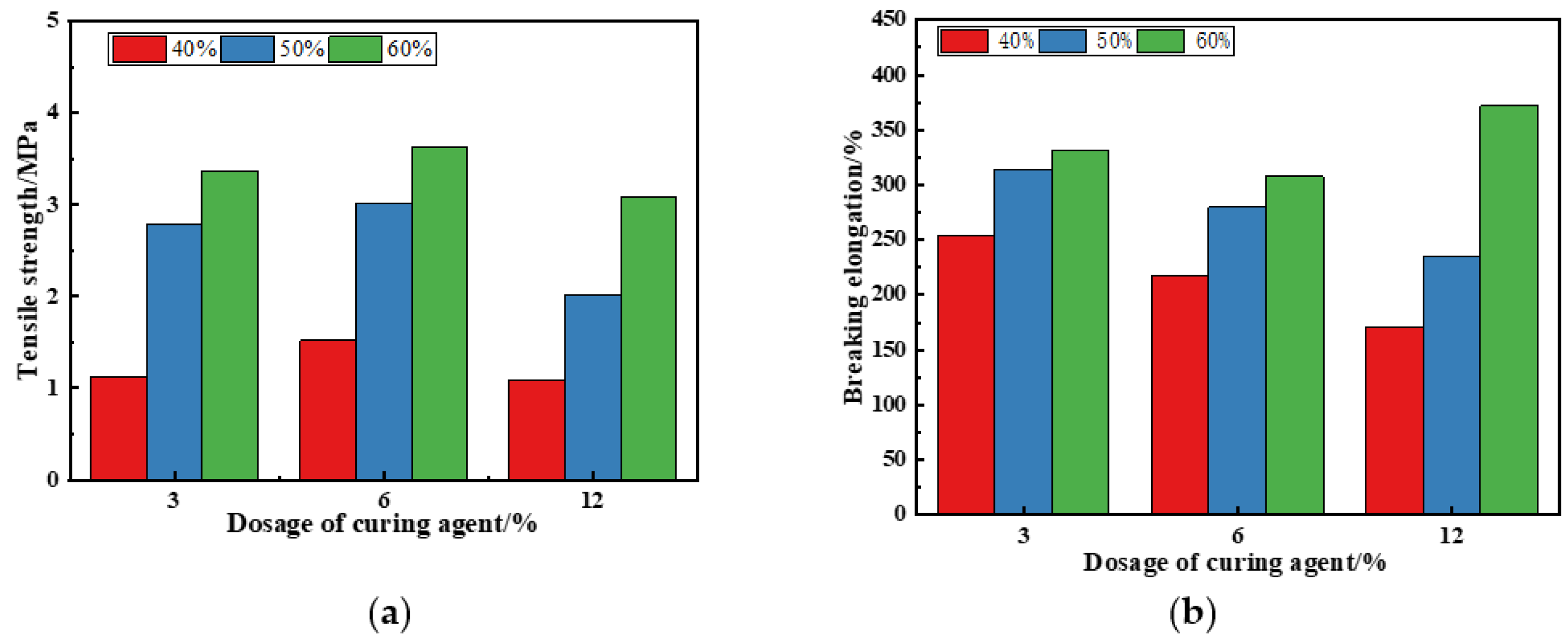


| Performance Indicators | Penetration (25 °C)/0.1 mm | Ductility (10 °C)/cm | Softening Point/°C | Flash Point/°C | Wax Content/% | Density (15 °C)/(g·cm−3) |
|---|---|---|---|---|---|---|
| Test results | 65.3 | 56 | 48 | 330 | 203 | 1.036 |
| Aggregate Size | Apparent Relative Gravity/γa | Relative Density of Bulk Volume/γb | Water Absorption (%) | Asphalt Absorption Coefficient | Effective Relative Density (g/cm3) |
|---|---|---|---|---|---|
| Limestone 12–16 mm | 3.315 | 3.227 | 1.10 | 0.38 | 3.307 |
| Limestone 6–12 mm | 2.935 | 2.823 | 1.33 | 0.59 | 2.895 |
| Limestone 4–6 mm | 2.773 | 2.721 | 1.68 | 0.79 | 2.715 |
| Limestone 0–4 mm | 2.692 | 2.573 | 1.80 | 0.92 | 2.687 |
| Mineral powder | 2.636 | 2.636 | - | - | 2.636 |
| Numbering | Type | CA Type | Tensile Strength/MPa | Breaking Elongation/% |
|---|---|---|---|---|
| GXJ-1 | PU prepolymer | Small molecule polyol (CA-1) | 11.9 | 330 |
| GXJ-2 | PU prepolymer | Small molecule polyol (CA-1) | 20.4 | 183 |
| GXJ-3 | Castor oil | Isocyanate (CA-2) | 15.2 | 80 |
| GXJ-4 | Polyether polyol | Isocyanate (CA-2) | 18.6 | 245 |
| Numbering | Gradation Type | PU Type | OAC/% | VV/% | VMA/% | VFA/% |
|---|---|---|---|---|---|---|
| PU asphalt | AC-13 | GXJ-1 | 6.1 | 4.1 | 14.9 | 72.5 |
| 70#A asphalt | AC-13 | - | 4.5 | 4.3 | 15.3 | 71.89 |
| Orthogonal Factors | PU Content (A) | Preparation Method (B) | CA Content (C) |
|---|---|---|---|
| 1 | 40% | Prefabrication method | 3% |
| 2 | 50% | Post-doping method | 6% |
| 3 | 60% | Pre-reaction method | 12% |
| Numbering | Orthogonal Composite | A | B | C |
|---|---|---|---|---|
| 1 | A1B1C3 | 40 | 1 | 12 |
| 2 | A1B2C1 | 40 | 2 | 3 |
| 3 | A1B3C2 | 40 | 3 | 6 |
| 4 | A2B1C1 | 50 | 1 | 3 |
| 5 | A2B2C2 | 50 | 2 | 6 |
| 6 | A2B3C3 | 50 | 3 | 12 |
| 7 | A3B1C2 | 60 | 1 | 6 |
| 8 | A3B2C3 | 60 | 2 | 12 |
| 9 | A3B3C1 | 60 | 3 | 3 |
| Preparation Method | Description |
|---|---|
| Prefabrication method | The base asphalt is sheared with polyurethane. After the shearing process, the CA is added and then mixed with the aggregate. |
| Post-doping method | The base asphalt is sheared with the CA; after the shearing process, it is mixed with the aggregate, and polyurethane is added during the mixing process. |
| Pre-reaction method | The polyurethane is sheared with the CA. Following the shearing process, the base asphalt is added and then mixed with the aggregate. |
| Number | Orthogonal Composite | 3d Split Strength/MPa | 5d Split Strength/Mpa | 7d Split Strength/Mpa | Freeze-Thaw Splitting Strength/Mpa | TSR/% |
|---|---|---|---|---|---|---|
| 1 | A1B1C3 | 1.32 | 1.44 | 1.93 | 1.12 | 64.48 |
| 2 | A1B2C1 | 1.23 | 1.74 | 1.96 | 1.4 | 79.37 |
| 3 | A1B3C2 | 1.12 | 1.28 | 1.46 | 1.02 | 77.63 |
| 4 | A2B1C1 | 1.57 | 1.97 | 2.26 | 1.98 | 87.82 |
| 5 | A2B2C2 | 1.47 | 1.86 | 2.11 | 1.57 | 82.68 |
| 6 | A2B3C3 | 1.13 | 1.14 | 1.64 | 1.15 | 77.91 |
| 7 | A3B1C2 | 1.58 | 2.10 | 2.57 | 2.01 | 83.52 |
| 8 | A3B2C3 | 1.77 | 2.08 | 2.37 | 1.8 | 75.01 |
| 9 | A3B3C1 | 1.46 | 1.68 | 1.96 | 1.31 | 74.26 |
| Response Value | PU Content | Preparation Method | Dosage of CA | Error Value | |
|---|---|---|---|---|---|
| 3d Splitting strength | SS | 0.218 | 0.128 | 0.001 | 0.046 |
| d/f | 2 | 2 | 2 | 2 | |
| MS | 0.109 | 0.064 | 0.001 | 0.023 | |
| F | 4.77 | 2.81 | 0.03 | ||
| 5d Splitting strength | SS | 0.335 | 0.501 | 0.099 | 0.027 |
| d/f | 2 | 2 | 2 | 2 | |
| MS | 0.167 | 0.251 | 0.050 | 0.014 | |
| F | 12.29 | 18.42 | 3.64 | ||
| 7d Splitting strength | SS | 0.411 | 0.501 | 0.007 | 0.007 |
| d/f | 2 | 2 | 2 | 2 | |
| MS | 0.205 | 0.251 | 0.003 | 0.003 | |
| F | 60.20 | 73.50 | 1.03 | ||
| Freeze-thaw splitting strength | SS | 0.410 | 0.526 | 0.157 | 0.093 |
| d/f | 2 | 2 | 2 | 2 | |
| MS | 0.205 | 0.263 | 0.078 | 0.046 | |
| F | 4.43 | 5.68 | 1.69 | ||
| TSR | SS | 0.024 | 0.011 | 0.027 | 0.018 |
| d/f | 2 | 2 | 2 | 2 | |
| MS | 0.012 | 0.005 | 0.013 | 0.009 | |
| F | 1.31 | 0.59 | 1.46 | ||
| Response Value | Quadratic Sum | Degree of Freedom | Mean Square | F Ratio | p-Value (>F) 1 | |
|---|---|---|---|---|---|---|
| 7d Splitting Strength | Model | 0.926 | 6 | 0.003 | 14.88 | 0.0002 |
| PU content | 0.411 | 2 | 0.205 | 22.83 | 0.0003 | |
| Preparation method | 0.501 | 2 | 0.251 | 15.42 | 0.0017 | |
| Dosage of CA | 0.007 | 2 | 0.004 | 6.38 | 0.0253 | |
| Freeze-thaw splitting strength | Model | 1.87 | 6 | 0.21 | 19.67 | 0.0001 |
| PU content | 0.60 | 2 | 0.60 | 56.86 | 0.0002 | |
| Preparation method | 0.78 | 2 | 0.78 | 73.79 | 0.0001 | |
| Dosage of CA | 0.23 | 2 | 0.23 | 21.62 | 0.0109 | |
| TSR | Model | 199.36 | 6 | 22.15 | 35.52 | 0.0001 |
| PU content | 8.41 | 2 | 8.41 | 13.49 | 0.0079 | |
| Preparation method | 11.98 | 2 | 11.98 | 19.21 | 0.0032 | |
| Dosage of CA | 111.30 | 2 | 111.30 | 178.48 | 0.0001 | |
| PU Content | Preparation Method | Dosage of CA |
|---|---|---|
| 56.64% | Prefabrication method | 3.58% |
Disclaimer/Publisher’s Note: The statements, opinions and data contained in all publications are solely those of the individual author(s) and contributor(s) and not of MDPI and/or the editor(s). MDPI and/or the editor(s) disclaim responsibility for any injury to people or property resulting from any ideas, methods, instructions or products referred to in the content. |
© 2023 by the authors. Licensee MDPI, Basel, Switzerland. This article is an open access article distributed under the terms and conditions of the Creative Commons Attribution (CC BY) license (https://creativecommons.org/licenses/by/4.0/).
Share and Cite
Sun, M.; Jing, S.; Wu, H.; Zhong, J.; Yang, Y.; Zhu, Y.; Xu, Q. Preparation Scheme Optimization of Thermosetting Polyurethane Modified Asphalt. Polymers 2023, 15, 2327. https://doi.org/10.3390/polym15102327
Sun M, Jing S, Wu H, Zhong J, Yang Y, Zhu Y, Xu Q. Preparation Scheme Optimization of Thermosetting Polyurethane Modified Asphalt. Polymers. 2023; 15(10):2327. https://doi.org/10.3390/polym15102327
Chicago/Turabian StyleSun, Min, Shuo Jing, Haibo Wu, Jun Zhong, Yongfu Yang, Ye Zhu, and Qingpeng Xu. 2023. "Preparation Scheme Optimization of Thermosetting Polyurethane Modified Asphalt" Polymers 15, no. 10: 2327. https://doi.org/10.3390/polym15102327
APA StyleSun, M., Jing, S., Wu, H., Zhong, J., Yang, Y., Zhu, Y., & Xu, Q. (2023). Preparation Scheme Optimization of Thermosetting Polyurethane Modified Asphalt. Polymers, 15(10), 2327. https://doi.org/10.3390/polym15102327








